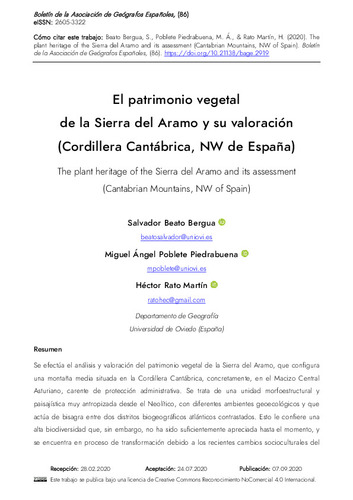El patrimonio vegetal de la Sierra del Aramo y su valoración (Cordillera Cantábrica, NW de España)
Otros títulos:
The plant heritage of the Sierra del Aramo and its assessment (Cantabrian Mountains, NW of Spain)
Autor(es) y otros:
Palabra(s) clave:
hábitats de interés comunitario
cartografía del medio natural
Red Natura 2000
Lanbioeva
Macizo Central Asturiano
Fecha de publicación:
Versión del editor:
Citación:
Descripción física:
Resumen:
Se efectúa el análisis y valoración del patrimonio vegetal de la Sierra del Aramo, que configura una montaña media situada en la Cordillera Cantábrica, concretamente, en el Macizo Central Asturiano, carente de protección administrativa. Se trata de una unidad morfoestructural y paisajística muy antropizada desde el Neolítico, con diferentes ambientes geoecológicos y que actúa de bisagra entre dos distritos biogeográficos atlánticos contrastados. Esto le confiere una alta biodiversidad que, sin embargo, no ha sido suficientemente apreciada hasta el momento, y se encuentra en proceso de transformación debido a los recientes cambios socioculturales del medio rural. Para lograr una adecuada evaluación de la riqueza patrimonial se cartografían y analizan las formaciones vegetales, a través de un minucioso trabajo de campo, fotointerpretación y SIG, al tiempo que se identifican los hábitats de interés comunitario y se aplica el método de valoración biogeográfica Lanbioeva (Landscape Biogeographic Evaluation). Como resultado, se delimitan 18 hábitats de interés comunitario que ocupan casi la mitad del área de estudio y se evalúan 21 formaciones vegetales, de las cuales ocho comunidades alcanzan una prioridad de conservación elevada, por encima de los 2000 puntos.
Se efectúa el análisis y valoración del patrimonio vegetal de la Sierra del Aramo, que configura una montaña media situada en la Cordillera Cantábrica, concretamente, en el Macizo Central Asturiano, carente de protección administrativa. Se trata de una unidad morfoestructural y paisajística muy antropizada desde el Neolítico, con diferentes ambientes geoecológicos y que actúa de bisagra entre dos distritos biogeográficos atlánticos contrastados. Esto le confiere una alta biodiversidad que, sin embargo, no ha sido suficientemente apreciada hasta el momento, y se encuentra en proceso de transformación debido a los recientes cambios socioculturales del medio rural. Para lograr una adecuada evaluación de la riqueza patrimonial se cartografían y analizan las formaciones vegetales, a través de un minucioso trabajo de campo, fotointerpretación y SIG, al tiempo que se identifican los hábitats de interés comunitario y se aplica el método de valoración biogeográfica Lanbioeva (Landscape Biogeographic Evaluation). Como resultado, se delimitan 18 hábitats de interés comunitario que ocupan casi la mitad del área de estudio y se evalúan 21 formaciones vegetales, de las cuales ocho comunidades alcanzan una prioridad de conservación elevada, por encima de los 2000 puntos.
ISSN:
Ficheros en el ítem





